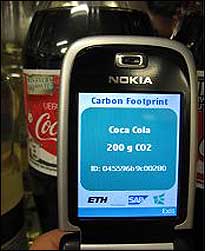The Bits to Energy Lab, a joint research initiative of the University of St. Gallen and ETH Zurich in Switzerland, is studying how to use data collected via RFID to calculate an individual item’s carbon footprint, then display that information on an RFID-enabled mobile phone. The project is part of the lab’s overall efforts to find ways to employ ubiquitous computing technologies—always-on, always-connected—to promote environmentally healthier practices, and to achieve a more rational use of energy.
A product’s carbon footprint is usually defined as the average amount of greenhouse gases emitted to produce, transport, use and recycle that product. A dynamic carbon footprint, on the other hand, is defined as the cumulative emission of greenhouse gas on a per-unit basis. Individual batches of the same product—such as two cases of a specific brand of juice—can have widely varying dynamic carbon footprints. If one case on a supermarket shelf came from a particular bottling plant, while one next to it originated at a different plant several hundred kilometers away and was delivered by a separate logistics company, their footprints could diverge significantly.
If individual items or cases of items can be identified, it would be possible to assign each item its share of emissions. Companies such as supermarket chains Tesco and Migros have shown interest in carbon-footprinting their products as a means of improving processes and products through higher visibility of environmental costs on a per-unit basis. What’s more, knowing an individual product’s dynamic carbon footprint can help companies avoid compliance penalties, improve their reputations with environmentally conscious consumers and potentially save them money.
“There are a lot of projects that optimize efficiency of the supply chain with RFID,” says Thorsten Staake, associate director of the Bits to Energy Lab. “We are trying to optimize emission efficiency with RFID. It’s slightly different—and sometimes, but not always, it is related to costs.”
Ali Dada, a researcher at the Bits to Energy Lab, adds, “We are investigating the value of item-level footprinting. RFID, with its ability to uniquely identify items and automate the collection of information in the supply chain, would supply additional value and ease of usage in the supply chain.”
At present, a number of organizations, such as Carbon Trust and Climatop, are applying various methodologies for carbon accounting in pilot projects. The Bits to Energy Lab is working informally with these organizations as they develop carbon-footprinting methodologies. Bits to Energy researchers are utilizing results from the carbon-accounting projects to help them understand how the methodologies can be used in conjunction with Electronic Product Code (EPC) RFID technology.
“The EPC will generate lots of information that can be used to calculate the item-level footprint,” Dada says. “Our job is to combine EPC item-level information and somehow match that to the methodology. For instance, we can find out which supply chains the product went through, and how much energy was used in that supply chain.”
Once EPC codes can be incorporated into methodologies, the researchers plan to make it possible for consumers to ascertain a product’s carbon footprint by reading that product’s RFID tag with a mobile phone’s built-in Near Field Communication (NFC) RFID interrogator. In May 2008, at a conference in Sydney, Australia, Dada and his fellow researchers presented a paper on the concept and provided a basic demonstration of it. Using data saved on RFID tags, participants in the demonstration could read the information with mobile phones and obtain a better understanding of how the system will eventually work—that is, provide a carbon footprint for each individual product.
“This gives the consumer a chance to make multiple comparisons and reward the products with the lower dynamic footprints,” Dada says. “Displaying and representing the data in a non-intrusive and easy-to-digest way sounds trivial, but it’s hard to do.”
The researchers say they are convinced that EPC, in general, will play a major role in item-level carbon footprinting, by combining data obtained from an EPC RFID system with carbon footprint data from numerous stakeholders. “[EPC RFID technology] already provides most of what we need,” Staake notes. “The solution may be another field in the database. It’s basically a jump-start toward carbon accounting. You would need something similar for carbon accounting.”
Funding for the Bits to Energy Lab comes from several industry projects, including those sponsored by EPCglobal and private companies, which Staake declines to name.



